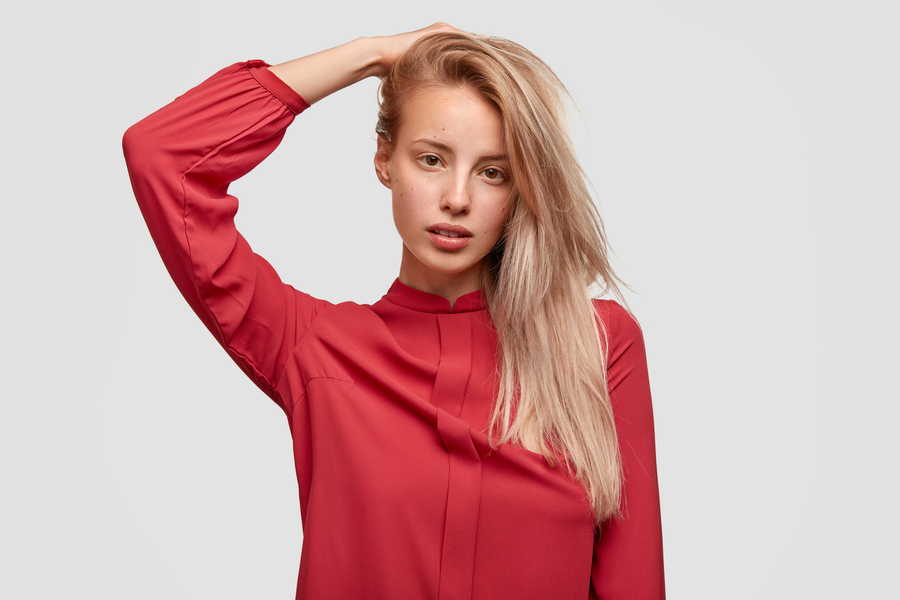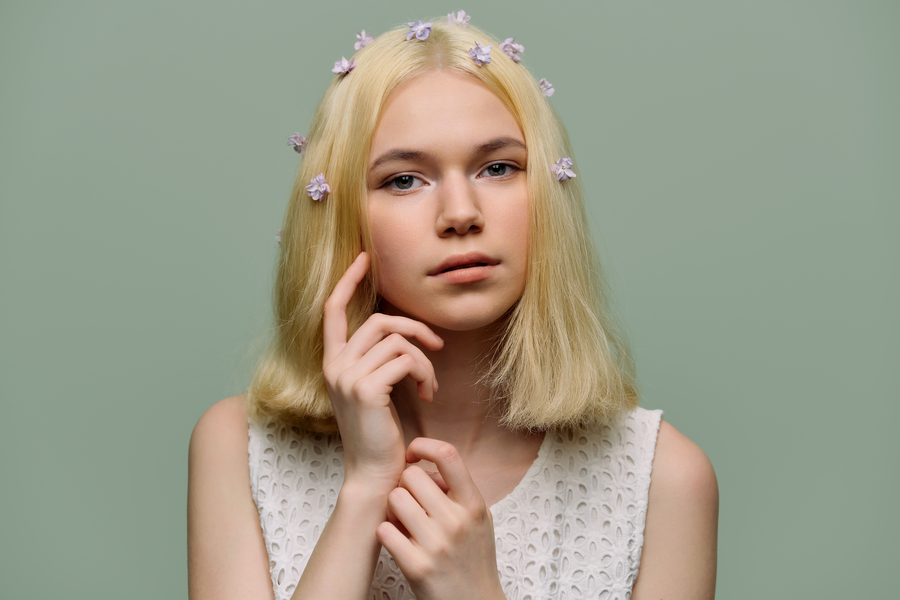Long Blonde Hair: Care Tips for Healthy, Beautiful Length

Introduction
Long blonde hair has always been a symbol of beauty and femininity, captivating attention with its sun-kissed glow and flowing length. However, maintaining healthy long blonde locks requires special care and attention. Blonde hair, especially when long, faces unique challenges including increased vulnerability to damage, color fading, and breakage.
At Platinum Blonde Studio, we've helped countless clients achieve and maintain gorgeous long blonde hair. Whether you're naturally blonde or have colored your hair, this comprehensive guide will provide you with professional tips and strategies to keep your long blonde hair looking its absolute best.
"The journey to beautiful long blonde hair is a marathon, not a sprint. Consistency in your care routine is what transforms good hair into great hair." — Senior Stylist, Platinum Blonde Studio
What You'll Learn in This Article
- Unique Challenges of Long Blonde Hair
- Daily Care Routine for Long Blonde Hair
- Washing and Conditioning Techniques
- Essential Products for Long Blonde Hair
- Heat Styling: Best Practices
- Nutrition and Supplements for Hair Growth
- Professional Treatments Worth Investing In
- Protective Hairstyles for Long Blonde Hair
- Seasonal Care Adjustments
- Common Mistakes to Avoid
- Conclusion: Your Long Blonde Hair Journey
Unique Challenges of Long Blonde Hair
Long blonde hair faces several distinct challenges that require specialized care approaches:
Increased Porosity and Fragility
Blonde hair, particularly if lightened, has a more open cuticle structure making it more porous and prone to damage. When this hair is also long, the ends have been exposed to environmental stressors, styling, and washing for a longer period, compounding the vulnerability.
Color Maintenance
Blonde shades are notorious for developing unwanted tones—brassiness, yellowing, or dullness—especially in longer hair where the ends may have been colored multiple times or exposed to more environmental factors.
Moisture Balance
Long blonde hair often struggles with maintaining proper moisture balance. The lightening process can strip natural oils, while the length means that natural oils from the scalp have a longer journey to travel to nourish the ends.
Tangling and Breakage
The combination of length and the typically finer texture of blonde hair creates perfect conditions for tangling. Each tangle represents a potential breaking point, especially when the hair is wet or being styled.
Weight and Tension
The sheer weight of long hair creates tension at the roots, which can lead to breakage or even hair loss over time, particularly for those with fine blonde hair that may not have the strength to support the length.
Daily Care Routine for Long Blonde Hair
Establishing a consistent daily care routine is essential for maintaining the health and beauty of long blonde hair:
Morning Care
Start your day by gently detangling your hair with a wide-tooth comb or specialized detangling brush, working from the ends up to the roots. Apply a lightweight leave-in conditioner or heat protectant if you'll be using heat styling tools. For naturally blonde hair, consider using a UV protection spray to prevent sun-induced color changes.
Evening Care
Before bed, gently brush your hair with a boar bristle brush to distribute natural oils from root to tip. This is especially important for long blonde hair as the ends are far from the oil-producing scalp. Secure your hair in a loose braid or silk scrunchie to prevent overnight tangling, and consider sleeping on a silk or satin pillowcase to reduce friction and moisture loss.
Pro Tip: Nighttime Oil Treatment
Once a week, apply a few drops of argan or jojoba oil to the ends of your hair before bed. This overnight treatment helps seal moisture into porous blonde ends and prevents splitting.
Washing and Conditioning Techniques
How you wash and condition your long blonde hair can make a significant difference in its health and appearance:
Washing Frequency
Over-washing can strip natural oils and fade color, while under-washing can lead to buildup and dullness. For most long blonde hair, washing 2-3 times per week is ideal. If you have oily roots, consider using a dry shampoo between washes rather than increasing washing frequency.
Pre-Wash Treatments
Before shampooing, apply a pre-wash treatment or oil to the lengths and ends of your hair. This creates a protective barrier that prevents the shampoo from over-stripping already vulnerable blonde strands.
Proper Shampooing Technique
Focus shampoo application on the scalp and roots where oil production occurs. Gently massage with fingertips (not nails) to stimulate circulation without causing breakage. Allow the suds to naturally flow down the lengths during rinsing rather than scrubbing the mid-lengths and ends directly.
Conditioning Strategy
Apply conditioner primarily to mid-lengths and ends, avoiding the roots unless you have very dry hair. For long blonde hair, a "sandwich" conditioning method can be beneficial: apply regular conditioner, rinse partially, then apply a small amount of leave-in conditioner before final rinsing.
Rinsing Temperature
While warm water helps open the cuticle for cleansing, always finish with a cool water rinse to seal the cuticle, enhance shine, and lock in moisture—particularly important for porous blonde hair.
| Water Temperature | Benefits | Drawbacks | Best For |
|---|---|---|---|
| Hot | Removes buildup effectively | Strips natural oils, opens cuticle too much, can fade color | Avoid for blonde hair |
| Warm | Opens cuticle moderately, removes dirt | Can still contribute to some color fading | Initial shampooing phase |
| Cool | Seals cuticle, enhances shine, preserves color | Less effective at removing oils and buildup | Final rinse |
| Cold | Maximum shine, tightly seals cuticle | Can be uncomfortable | Quick final rinse for special occasions |
Essential Products for Long Blonde Hair
Investing in the right products is crucial for maintaining the health and vibrancy of long blonde hair:
Purple Shampoo and Conditioner
These violet-toned products are essential for neutralizing yellow and brassy tones that naturally develop in blonde hair. Use once a week for maintenance or twice a week for more aggressive toning. Be careful not to overuse, as purple products can be drying and may give hair a lavender tint if used too frequently.
Bond-Building Treatments
Products containing bond-building technology (like Olaplex, K18, or similar) are particularly beneficial for long blonde hair that has been chemically processed. These treatments work at a molecular level to repair broken disulfide bonds within the hair shaft, significantly reducing breakage and improving elasticity.
Protein-Moisture Balance Products
Long blonde hair requires a careful balance of protein and moisture. Look for products that specify they help maintain this balance. Signs of protein overload include stiff, brittle hair that breaks easily, while moisture overload presents as limp, gummy hair that stretches before breaking.
Lightweight Oils and Serums
Choose lightweight formulations specifically designed for blonde hair. Heavier oils can make blonde hair look dull or greasy. Argan oil, jojoba oil, and silicone-free serums are excellent options for sealing the ends without weighing down the hair.
Heat Protectants
These are non-negotiable for long blonde hair that undergoes heat styling. Look for protectants that shield against temperatures up to 450°F (232°C) and offer UV protection for comprehensive care.
Product Rotation Strategy
For optimal results, rotate between different product systems rather than using the same products continuously. This prevents buildup and ensures your hair receives a variety of nutrients and treatments. For example, alternate between purple-toning products, clarifying products, and intensive moisture treatments on a weekly basis.
Heat Styling: Best Practices
Heat styling is particularly damaging to long blonde hair, but with the right approach, you can minimize harm:
Temperature Settings
Always use the lowest effective temperature setting for your hair type. For fine blonde hair, stay below 300°F (149°C); for medium blonde hair, 300-350°F (149-177°C); and for coarse blonde hair, 350-375°F (177-190°C). Avoid going above 375°F (190°C) even for the coarsest blonde hair.
Tool Quality
Invest in high-quality heat styling tools with ceramic, tourmaline, or titanium plates/barrels that distribute heat evenly. Look for tools with multiple temperature settings and automatic shut-off features. Cheap tools often have uneven heating that can create hot spots and cause severe damage to blonde hair.
Technique Matters
When using flat irons, take small sections and pass through the hair quickly rather than holding the iron on one spot. For curling irons or wands, don't leave hair wrapped around the barrel for more than 5-8 seconds. Always curl away from the face for a more modern, flattering look.
Heat-Free Styling Alternatives
Embrace heat-free styling methods whenever possible. Techniques like overnight braiding, twist-outs, or using foam rollers can create beautiful waves and curls without heat damage. These methods are particularly beneficial for maintaining the integrity of long blonde hair.
| Tool Type | Best Features for Blonde Hair | Damage Potential | Best For |
|---|---|---|---|
| Flat Iron | Ceramic plates, adjustable temperature, automatic shut-off | High (direct heat contact) | Sleek, straight styles |
| Curling Iron | Ceramic or tourmaline barrel, digital temperature control | Medium-High | Defined curls and waves |
| Hot Air Brush | Ionic technology, ceramic bristles | Medium | Volume and gentle waves |
| Blow Dryer | Ionic technology, multiple heat settings, cool shot button | Medium (depends on technique) | Basic drying and styling |
Nutrition and Supplements for Hair Growth
Beautiful long blonde hair starts from within. The right nutrition and supplements can significantly impact hair health and growth:
Essential Nutrients
Focus on foods rich in biotin, vitamins A, C, D, and E, zinc, iron, and omega-3 fatty acids. These nutrients support hair follicle function, sebum production, and protein synthesis—all critical for healthy blonde hair growth.
Protein Intake
Hair is primarily made of keratin, a type of protein. Ensure adequate protein intake (about 0.8g per kg of body weight daily) from sources like lean meats, fish, eggs, dairy, legumes, and plant-based proteins. This is especially important for those with long blonde hair, as protein deficiency can lead to dullness and breakage.
Hydration
Proper hydration is essential for nutrient delivery to hair follicles. Aim for at least 8 glasses of water daily, and consider adding electrolytes if you're very active or live in a hot climate.
Supplements for Blonde Hair
Consider supplements specifically formulated for hair growth, such as those containing biotin, collagen, silica, and MSM (methylsulfonylmethane). For blonde hair specifically, supplements with vitamin C can help prevent oxidative stress that may darken natural blonde shades over time.
"While topical treatments address the hair you already have, nutrition affects the hair that's still growing. For long blonde hair that takes years to reach its full length, this internal approach is just as important as your external care routine." — Nutritionist and Hair Specialist, Platinum Blonde Studio
Professional Treatments Worth Investing In
Regular salon visits are essential for maintaining the health and beauty of long blonde hair. Here are the professional treatments that deliver the best results:
Gloss Treatments
Semi-permanent gloss treatments refresh blonde tones between color appointments, add shine, and smooth the cuticle. For long blonde hair, these treatments are particularly beneficial as they can address the different tonal needs of roots versus ends without causing additional damage.
Deep Conditioning Treatments
Professional-grade deep conditioning treatments use heat and pressure to drive moisture and nutrients deep into the hair shaft. These treatments can restore elasticity and shine to even the most damaged long blonde hair and are worth scheduling every 4-6 weeks.
Keratin Treatments
Modified keratin treatments (not the traditional Brazilian blowout) can help manage frizz and improve manageability in long blonde hair without causing further damage. Look for formaldehyde-free options that focus on strengthening rather than just straightening.
Split End Treatments
Treatments that seal split ends can extend the time between trims, which is valuable when you're growing or maintaining long blonde hair. While these treatments don't permanently repair splits, they can temporarily fuse them and prevent further splitting up the hair shaft.
Salon Communication Tip
When booking professional treatments for long blonde hair, always mention both your hair length and that it's blonde. This allows your stylist to allocate enough time and product, as long blonde hair often requires more of both compared to shorter or darker hair types.
Protective Hairstyles for Long Blonde Hair
How you wear your hair day-to-day significantly impacts its health. These protective styles minimize damage while still looking polished:
Loose Braids
Loose French braids, Dutch braids, or simple three-strand braids keep long blonde hair contained and protected from environmental damage and friction. Avoid tight braiding, especially near the hairline, as this can cause traction alopecia over time.
Low Buns and Chignons
Low-positioned buns and chignons minimize tension on the hair shaft and roots. Secure with spin pins or hair sticks rather than elastic bands when possible, and avoid pulling the hair too tightly.
Half-Up Styles
Half-up styles offer a compromise between wearing your hair down and fully up. They keep hair off the face and reduce tangling while still showcasing your length. Use gentle clips, pins, or silk scrunchies to secure without causing breakage.
Silk Wrapping
For overnight protection, consider silk wrapping techniques or using a silk bonnet. This minimizes friction against cotton pillowcases, reducing breakage and tangling while preserving your blonde color by preventing moisture loss.
Seasonal Care Adjustments
Long blonde hair requires different care approaches throughout the year:
Summer Protection
UV rays, chlorine, and saltwater can be particularly damaging to blonde hair. In summer, increase your use of UV-protective products, wear hats when in direct sunlight, and always rinse with fresh water after swimming. Consider using leave-in conditioners with UV filters specifically formulated for blonde hair.
Winter Hydration
Cold weather and indoor heating can severely dry out long blonde hair. During winter months, step up your deep conditioning routine, consider using a humidifier indoors, and protect your hair from friction caused by scarves and high collars with silk-lined accessories or protective styling.
Spring Refresh
Spring is an ideal time for clarifying treatments to remove winter product buildup and refresh your blonde tone. Consider scheduling a professional gloss treatment or using at-home color-refreshing masks to address any dullness that developed during winter.
Fall Strengthening
Focus on protein treatments and strengthening routines during fall to prepare your hair for the coming winter. This is also a good time to trim away summer damage while maintaining your length.
Common Mistakes to Avoid
Even with the best intentions, many long blonde hair care routines include these damaging practices:
Brushing Wet Hair Incorrectly
Wet blonde hair is particularly vulnerable to breakage. Always use a wide-tooth comb or specialized wet brush, start from the ends and work up, and consider applying a detangling product before attempting to brush.
Overusing Purple Products
While purple shampoos and conditioners are essential for tone maintenance, overuse can lead to protein buildup, dryness, and a dull, ashy appearance. Limit use to 1-2 times weekly and always follow with hydrating treatments.
Skipping Trims
Regular trims (every 10-12 weeks) are essential even when growing long blonde hair. Trimming prevents splits from traveling up the hair shaft, which can actually lead to more length loss in the long run.
Using the Wrong Hair Ties
Metal clasps, rubber bands, and rough-textured hair ties can catch and break blonde hair. Opt for smooth silk scrunchies, spiral hair ties, or fabric-covered elastics positioned to minimize tension and moved frequently to prevent breakage in the same spot.
Neglecting Scalp Care
A healthy scalp is essential for growing and maintaining long blonde hair. Avoid products with harsh sulfates, incorporate regular gentle exfoliation, and consider scalp treatments that balance oil production and support follicle health.
Conclusion: Your Long Blonde Hair Journey
Maintaining long, healthy blonde hair is undoubtedly a commitment, but the stunning results are well worth the effort. By understanding the unique needs of long blonde hair and implementing a comprehensive care routine, you can enjoy beautiful, head-turning locks that maintain their health and vibrancy at any length.
Remember that consistency is key—even the most expensive products and treatments won't deliver results without regular use and proper application. Be patient with your hair journey, as growing and maintaining long blonde hair is a marathon, not a sprint.
At Platinum Blonde Studio, we're passionate about helping our clients achieve their blonde hair goals. Whether you're naturally blonde or have colored your hair, our expert stylists can provide personalized recommendations and professional treatments to keep your long blonde hair looking its absolute best.
Ready to take your long blonde hair to the next level? Book a consultation with one of our blonde specialists today and discover the perfect care routine for your unique hair needs.
"Beautiful long blonde hair isn't just about genetics—it's about dedication, knowledge, and using the right techniques and products for your specific hair type and goals." — Founder, Platinum Blonde Studio


